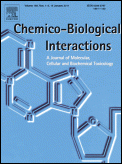Chemico-Biological Interactions
Chemico-Biological Interactions is a scientific field that explores the complex interactions between chemical compounds and biological systems. This interdisciplinary area encompasses aspects of chemistry, biology, pharmacology, and toxicology, aiming to understand how chemical substances affect living organisms at the molecular and cellular levels. The insights gained from these studies are crucial for the development of new medications, the assessment of environmental hazards, and the advancement of biotechnology.
Overview[edit | edit source]
Chemico-biological interactions involve the detailed analysis of how chemical agents interact with biomolecules such as proteins, nucleic acids (DNA and RNA), lipids, and carbohydrates. These interactions can alter the normal functioning of cells and organs, leading to various health effects. Understanding these mechanisms is essential for predicting the toxicity of substances, designing safer chemicals, and developing therapeutic strategies against diseases.
Key Areas of Study[edit | edit source]
The study of chemico-biological interactions covers several key areas, including:
- Drug Discovery and Development: Investigating how drugs interact with their biological targets to elicit therapeutic effects. This includes the study of drug-receptor interactions, enzyme inhibition, and the mechanisms of drug resistance.
- Toxicology: Examining how exposure to toxic substances affects living organisms. This includes understanding the molecular basis of toxicity, identifying biomarkers of exposure, and assessing risk.
- Environmental Chemistry: Studying the impact of chemicals found in the environment on biological systems. This includes the effects of pollutants, heavy metals, and endocrine disruptors on human health and ecosystems.
- Biochemistry: Exploring the chemical processes within and related to living organisms. This includes the study of metabolism, signal transduction pathways, and the chemical properties of biomolecules.
Methodologies[edit | edit source]
Research in chemico-biological interactions employs a variety of methodologies, including:
- Molecular Biology Techniques: Such as PCR (Polymerase Chain Reaction) for amplifying DNA, gel electrophoresis for DNA separation, and Western blotting for protein analysis.
- Bioinformatics: Using computational tools to analyze biological data. This includes genomics, proteomics, and metabolomics studies.
- Spectroscopy and Mass Spectrometry: For identifying and quantifying chemical substances in biological samples.
- Cell Culture and Animal Models: For studying the effects of chemicals in a controlled environment.
Challenges and Future Directions[edit | edit source]
One of the main challenges in the field of chemico-biological interactions is the complexity of biological systems. The vast number of variables involved in biological responses makes it difficult to predict the effects of chemicals accurately. Furthermore, the ethical concerns associated with animal testing and the need for alternative testing methods are driving research towards more sophisticated in vitro and computational models.
Future directions in chemico-biological interactions research include the development of more predictive models for assessing chemical safety, the discovery of new therapeutic targets, and the design of green chemistry approaches to reduce environmental impact.
Transform your life with W8MD's budget GLP1 injections from $125
W8MD offers a medical weight loss program NYC and a clinic to lose weight in Philadelphia. Our W8MD's physician supervised medical weight loss centers in NYC provides expert medical guidance, and offers telemedicine options for convenience.
Why choose W8MD?
- Comprehensive care with FDA-approved weight loss medications including:
- loss injections in NYC both generic and brand names:
- weight loss medications including Phentermine, Qsymia, Diethylpropion etc.
- Accept most insurances for visits or discounted self pay cost.
- Generic weight loss injections starting from just $125.00 for the starting dose
- In person weight loss NYC and telemedicine medical weight loss options in New York city available
- Budget GLP1 weight loss injections in NYC starting from $125.00 biweekly with insurance!
Book Your Appointment
Start your NYC weight loss journey today at our NYC medical weight loss, and Philadelphia medical weight loss Call (718)946-5500 for NY and 215 676 2334 for PA
Search WikiMD
Ad.Tired of being Overweight? Try W8MD's NYC physician weight loss.
Semaglutide (Ozempic / Wegovy and Tirzepatide (Mounjaro / Zepbound) available. Call 718 946 5500.
Advertise on WikiMD
|
WikiMD's Wellness Encyclopedia |
| Let Food Be Thy Medicine Medicine Thy Food - Hippocrates |
Translate this page: - East Asian
中文,
日本,
한국어,
South Asian
हिन्दी,
தமிழ்,
తెలుగు,
Urdu,
ಕನ್ನಡ,
Southeast Asian
Indonesian,
Vietnamese,
Thai,
မြန်မာဘာသာ,
বাংলা
European
español,
Deutsch,
français,
Greek,
português do Brasil,
polski,
română,
русский,
Nederlands,
norsk,
svenska,
suomi,
Italian
Middle Eastern & African
عربى,
Turkish,
Persian,
Hebrew,
Afrikaans,
isiZulu,
Kiswahili,
Other
Bulgarian,
Hungarian,
Czech,
Swedish,
മലയാളം,
मराठी,
ਪੰਜਾਬੀ,
ગુજરાતી,
Portuguese,
Ukrainian
Medical Disclaimer: WikiMD is not a substitute for professional medical advice. The information on WikiMD is provided as an information resource only, may be incorrect, outdated or misleading, and is not to be used or relied on for any diagnostic or treatment purposes. Please consult your health care provider before making any healthcare decisions or for guidance about a specific medical condition. WikiMD expressly disclaims responsibility, and shall have no liability, for any damages, loss, injury, or liability whatsoever suffered as a result of your reliance on the information contained in this site. By visiting this site you agree to the foregoing terms and conditions, which may from time to time be changed or supplemented by WikiMD. If you do not agree to the foregoing terms and conditions, you should not enter or use this site. See full disclaimer.
Credits:Most images are courtesy of Wikimedia commons, and templates, categories Wikipedia, licensed under CC BY SA or similar.
Contributors: Prab R. Tumpati, MD



